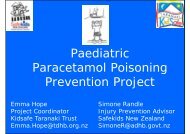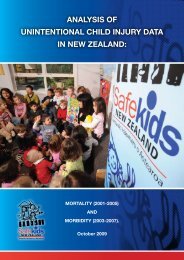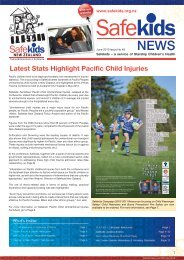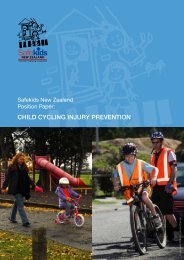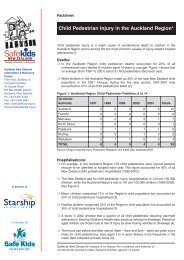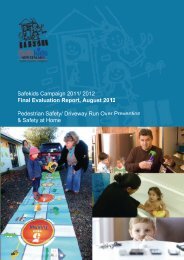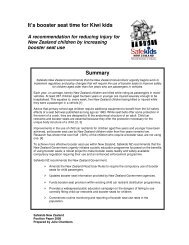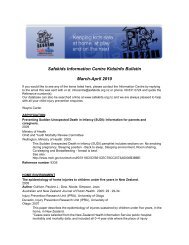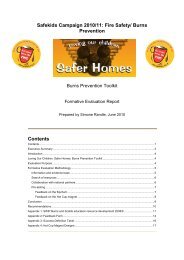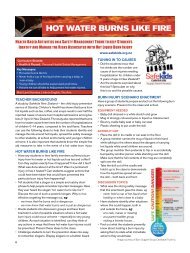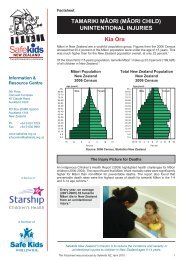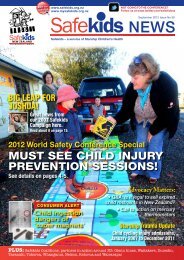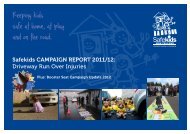Issue 60, March 2013 - Safekids
Issue 60, March 2013 - Safekids
Issue 60, March 2013 - Safekids
Create successful ePaper yourself
Turn your PDF publications into a flip-book with our unique Google optimized e-Paper software.
STARSHIP TRAUMA UPDATE/NEW RESOURCES<br />
Major sponsor:<br />
Television tip-over admissions, June 2006 to January <strong>2013</strong><br />
Background<br />
Child television tip-over injuries are increasing globally, in part due<br />
to a lack of public awareness and preventive measures. 1 The vast<br />
majority of TV-tip-over injuries occur in the home when a child<br />
is unsupervised, 2 the use of a dresser as a TV stand appears to<br />
convey the greatest risk of injury. 3 Blunt head trauma secondary<br />
to a TV falling on a child is the most common injury, followed by<br />
chest and abdominal trauma. 4 United States consensus population<br />
surveys reveal that 95% of households have at least one TV, 5 the<br />
trend in New Zealand households is likely to be similar. 6 TV design<br />
and size has changed in recent years, and the impact of this change<br />
on TV-tip-over risk and injury is unknown. 7, 8<br />
Demographics<br />
During the study period:<br />
• 28 children were admitted to Starship as a result of a TV tip-over<br />
injury<br />
• 57 percent (n=16) were male and 43 percent (n=12) were female<br />
• Half of the children (n=14) were aged two to four years old and<br />
29 percent (n=8) were under two years of age.<br />
• 57 percent (n=16) were coded as Māori, 21 percent (n=6) as<br />
Pacific, 13 percent (n=4) as European and nine percent as<br />
Chinese or Other.<br />
TV tip-over injuries by ethnicity and age<br />
0 to 1<br />
year<br />
2 to 4<br />
years<br />
5+ years Total<br />
Māori 5 9 ≤3 16<br />
Pacific ≤3 ≤3 0 6<br />
European 0 ≤3 ≤3 4<br />
Chinese 0 0 ≤3 ≤3<br />
Other 0 ≤3 0 ≤3<br />
Total 8 14 6 28<br />
Yearly trend<br />
Cell counts of one, two and three have been suppressed<br />
The median number of admissions per year was 4, with a maximum<br />
of 6 cases occurring in 2010.<br />
Seasonal trend<br />
TV tip-over admissions did not demonstrate a clear seasonal trend.<br />
Mechanism of injury<br />
Common mechanisms of injury involved the child climbing up on<br />
the TV stand/ furniture (n=6) and pulling the TV down (n=6). TVs<br />
also toppled as a result of the TV stand/ furniture being rocked or<br />
knocked. The mechanism of injury was unclear in the majority of<br />
cases.<br />
Injury location and type<br />
Head injuries were the most common form of injury. Eight children<br />
incurred multiple skull fractures (fractures to the base of the skull<br />
were most common), eight incurred single skull fractures and<br />
nine children incurred intracranial haemorrhages within various<br />
parts of the skull (including subarachnoid, subdural and extradural<br />
haemorrhages). Other injuries such as limb fractures and injuries<br />
(8), tracheal tears, neck strain and facial lacerations were also<br />
reported.<br />
Injury severity<br />
The Injury Severity Score<br />
(ISS) is an internationally<br />
recognised method for<br />
calculating the combined<br />
severity of injuries<br />
sustained. An ISS greater<br />
than ten indicates moderate<br />
or severe injury. Seven of the<br />
28 children admitted (25%)<br />
had an ISS greater than ten.<br />
The median ISS was seven.<br />
One child died.<br />
Key Messages 9<br />
Injuries from TV tip-overs are<br />
preventable. The use of TV<br />
mounts and furniture straps<br />
can help to keep children<br />
safe.<br />
• TV Safety Check<br />
° ° Assess the stability of the TVs in your home.<br />
° ° Flat screen TVs: mount it to the wall to reduce the risk of it<br />
toppling off stands. Follow the manufacturer’s instructions to<br />
ensure you protect your wall and have a secure fit.<br />
° ° Large, heavy, old-style cathode ray tube (CRT) TVs: place it on<br />
a low, stable piece of furniture.<br />
• Secure Furniture<br />
° ° Use brackets, braces or wall straps to secure unstable or topheavy<br />
furniture to the wall.<br />
° ° Install stops on dresser drawers to prevent them from being<br />
pulled all the way out. Multiple open drawers can cause the<br />
weight to shift, making it easier for a dresser to fall.<br />
• Rearrange Household Items<br />
° ° Keep heavier items on lower shelves or in lower drawers.<br />
° ° Avoid placing remote controls, food, toys or other items in<br />
places where kids might be tempted to climb up or reach for<br />
them.<br />
For more information on TV tip-overs and how to safely secure<br />
televisions, furniture and other heavy household objects visit<br />
the following websites:<br />
www.eqc.govt.nz/be-prepared/multimedia/quake-safe-your-home<br />
www.safekids.org/safety-basics/safety-spotlight/TV-andfurniture-tip-overs/<br />
www.consumerreports.org<br />
1<br />
C. DiScala, et al., “Outcomes from television sets toppling onto toddlers,” Archives of<br />
pediatrics & adolescent medicine, vol. 155, pp. 145-148, 2001.<br />
2<br />
Consumer Product Safety Commission, “CPSC Warns about TV, Large Furniture Tip-Over<br />
Dangers. More than 100 Deaths Reported Since 2000, Most Involve Young Children,”<br />
Consumer Product Safety Commission, Washington, USA, 2006.<br />
3<br />
J. D. Rutkoski, et al., “Traumatic television tip-overs in the pediatric patient population,”<br />
Journal of Surgical Research, vol. 166, pp. 199-204, 2011.<br />
4<br />
J. Marnewick, et al., “Television tip-overs: The Starship Children’s Hospital experience<br />
and literature review,” Injury, vol. 42, pp. 534-538, 2011.<br />
5<br />
P. A. Bernard, et al., “Toppled television sets cause significant pediatric morbidity and<br />
mortality,” Pediatrics, vol. 102, p. e32, 1998.<br />
6<br />
J. Marnewick, et al., “Television tip-overs: The Starship Children’s Hospital experience<br />
and literature review,” Injury, vol. 42, pp. 534-538, 2011.<br />
7<br />
P. A. Bernard, et al., “Toppled television sets cause significant pediatric morbidity and<br />
mortality,” Pediatrics, vol. 102, pp. p. e32, 1998.<br />
8<br />
J. Deisch, et al., “Craniocerebral Trauma Inflicted by Television Falls*,” Journal of Forensic<br />
Sciences, vol. 56, pp. 1049-1053, 2011.<br />
9<br />
Tip Sheet TV and Furniture Tip-Overs. Washington, USA, Safe Kids Worldwide: 2012.<br />
8<br />
<strong>Safekids</strong> News: <strong>March</strong> <strong>2013</strong> <strong>Issue</strong> No <strong>60</strong>



